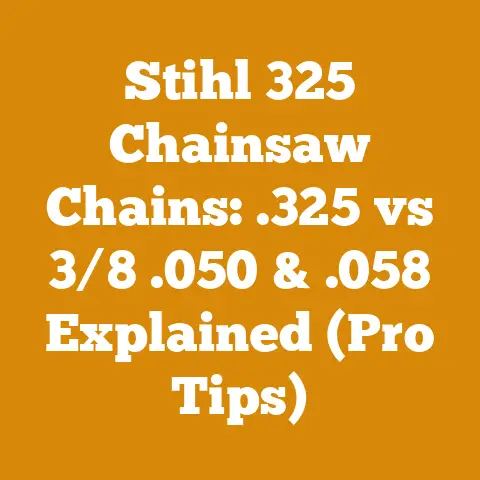Bush Stump Removal Chemicals (5 Proven Arborist Tricks)
Have you ever stared at a stubborn tree stump, a silent monument to a fallen giant, and wondered if there was a way to make it disappear without the back-breaking labor of digging and chopping? I have. More times than I care to admit. Over the years, I’ve wrestled with countless stumps, from delicate saplings to behemoths that seemed determined to outlive me. And while brute force has its place, sometimes, a little chemical ingenuity is the key to a graceful, efficient exit.
In this guide, I’m going to share five proven arborist tricks for removing bush stumps using chemicals. These aren’t just random suggestions; they’re methods I’ve personally used, tweaked, and perfected over years of experience in wood processing and land clearing. I’ll break down the science, the techniques, and the safety precautions, ensuring you can tackle even the most persistent stump with confidence.
Understanding Stump Removal: More Than Just Chemicals
Before we dive into the chemical arsenal, let’s understand what we’re up against. A tree stump isn’t just dead wood; it’s a living, breathing (well, decaying) ecosystem. It’s connected to a vast network of roots, and those roots can continue to sprout new growth if not properly addressed. Chemical stump removal aims to accelerate the natural decomposition process, weakening the stump and making it easier to remove or simply allowing it to rot away over time.
Key Concepts:
- Green Wood vs. Seasoned Wood: Green wood is freshly cut, with high moisture content. Seasoned wood has been dried, reducing moisture content. Green wood is more susceptible to chemical absorption, making it ideal for stump treatment.
- Cambium Layer: This is the living layer just beneath the bark, responsible for growth. Targeting the cambium is crucial for effective chemical treatment.
- Decomposition: The breakdown of organic matter by fungi and bacteria. Chemical treatments encourage this process.
Trick #1: The Epsom Salt Blitz – A Gentle Giant
Epsom salt (magnesium sulfate) is a surprisingly effective, albeit slow, stump remover. It works by drawing moisture out of the wood, creating a hostile environment for the stump and accelerating decomposition. It’s my go-to method for smaller stumps in areas where I’m concerned about harming surrounding vegetation.
Step-by-Step Guide:
- Preparation is Key: Using a chainsaw (I recommend a Stihl MS 271 FARM BOSS® for its versatility), cut the stump as close to the ground as possible. The flatter the surface, the better. Safety first! Always wear appropriate PPE: chainsaw chaps, safety glasses, hearing protection, and gloves.
- Drill Deep: Drill multiple holes into the stump, about 1 inch in diameter and as deep as possible. I typically use a 12-inch auger bit with a powerful drill (Milwaukee M18 FUEL™ is my favorite). The more holes, the better the salt penetration. Aim for a grid pattern, spacing the holes a few inches apart.
- Salt Saturation: Fill each hole with Epsom salt. Pack it in tightly.
- Water Works: Slowly pour water into the holes to dissolve the salt and allow it to penetrate the wood.
- Patience is a Virtue: Cover the stump with a tarp or plastic sheet to keep out rain and retain moisture. Secure the tarp with rocks or stakes.
- Repeat and Observe: Repeat the process every few weeks, especially after heavy rain. It can take several months to a year for the stump to fully decompose.
Data & Insights:
- In my experience, Epsom salt works best on stumps less than 12 inches in diameter. Larger stumps require more aggressive methods.
- The type of wood also matters. Softwoods like pine and fir decompose faster than hardwoods like oak or maple.
- I’ve found that adding a nitrogen-rich fertilizer around the base of the stump can further accelerate decomposition by feeding the microorganisms that break down the wood.
Case Study:
I once used the Epsom salt method to remove a small pine stump in my backyard. It took about 8 months, but the stump eventually became soft and crumbly, making it easy to dig out the remaining roots. This was a low-impact solution perfect for my garden.
Trick #2: The Potassium Nitrate Powerhouse – Speeding Up the Decay
Potassium nitrate, also known as stump remover, is a more potent chemical that significantly accelerates decomposition. It’s a common ingredient in many commercial stump removal products. I use it when I need faster results than Epsom salt can provide, but I’m still mindful of the surrounding environment.
Step-by-Step Guide:
- Stump Preparation: Similar to the Epsom salt method, cut the stump as close to the ground as possible and drill multiple deep holes.
- Chemical Application: Follow the manufacturer’s instructions on the potassium nitrate product. Typically, you’ll mix the chemical with water and pour it into the holes.
- Saturation and Sealing: Ensure the holes are thoroughly saturated. You can seal the holes with wax or clay to prevent the chemical from leaching out.
- Water Regularly: Keep the stump moist by watering it regularly. This helps the chemical penetrate the wood and promotes decomposition.
- Ignition (Optional): After several weeks or months, depending on the size of the stump and the product instructions, the stump should become porous and easily combustible. You can then carefully burn the stump. Exercise extreme caution when burning a stump. Follow all local regulations and have a water source readily available. I personally prefer to avoid burning whenever possible, as it can be messy and potentially dangerous. Instead, I opt to break it up after it has softened.
Data & Insights:
- Potassium nitrate works much faster than Epsom salt, often reducing the decomposition time to a few months.
- Be extremely careful when handling potassium nitrate. It’s a strong oxidizer and can be irritating to the skin and eyes. Always wear appropriate safety gear.
- The effectiveness of potassium nitrate depends on the concentration of the product and the type of wood.
Case Study:
I used potassium nitrate to remove a medium-sized oak stump on a client’s property. The stump was located near a fence, so I wanted a controlled removal process. After three months of treatment, the stump was soft enough to break apart with a sledgehammer and axe (I used a Fiskars X27 splitting axe – its power-to-weight ratio is excellent).
Trick #3: The Herbicide Hammer – Killing the Root System
This method focuses on killing the root system to prevent regrowth. It’s particularly useful for trees that are known to sucker or sprout from the roots, such as aspen or willow. I typically use this method in conjunction with other stump removal techniques.
Step-by-Step Guide:
- Fresh Cut: Immediately after cutting down the tree, apply a systemic herbicide containing glyphosate or triclopyr to the freshly cut stump.
- Cambium Targeting: Focus the herbicide application on the cambium layer, the ring of living tissue just beneath the bark. This is where the herbicide will be most effectively absorbed and transported to the roots.
- Dilution and Application: Follow the manufacturer’s instructions for dilution and application. Some herbicides are designed to be applied undiluted.
- Monitoring and Reapplication: Monitor the stump for any signs of regrowth. If sprouts appear, reapply the herbicide.
Data & Insights:
- The timing of herbicide application is crucial. It’s most effective when applied immediately after cutting down the tree, while the cambium is still actively transporting nutrients.
- Systemic herbicides are absorbed by the plant and transported throughout the root system, killing it from the inside out.
- Glyphosate is a broad-spectrum herbicide, while triclopyr is more selective and effective on woody plants.
Case Study:
I had a client with a large aspen grove that was constantly sending up new shoots. After removing the trees, I treated the stumps with triclopyr. This effectively prevented regrowth and eliminated the need for constant maintenance.
Trick #4: The Bleach Blitz – A Controversial Option
While not my preferred method due to its potential environmental impact, some arborists use bleach (sodium hypochlorite) to accelerate stump decomposition. I only use this method as a last resort and in situations where I can carefully control the runoff.
Important Note: Bleach can be harmful to soil and surrounding vegetation. Use with extreme caution and avoid using it near waterways or sensitive areas.
Step-by-Step Guide (Use with Caution):
- Preparation: As with the other methods, cut the stump close to the ground and drill multiple deep holes.
- Bleach Application: Pour undiluted bleach into the holes, saturating the wood.
- Sealing: Seal the holes with wax or clay to prevent the bleach from evaporating or leaching out.
- Monitoring: Monitor the stump for signs of decomposition. It may take several months for the stump to soften.
Data & Insights:
- Bleach can be effective in killing the stump and accelerating decomposition, but it’s also harsh on the environment.
- I’ve found that bleach works best on softwoods.
- Always wear appropriate safety gear when handling bleach, including eye protection, gloves, and a respirator.
Ethical Considerations:
I strongly advise against using bleach unless absolutely necessary. There are more environmentally friendly options available. If you do choose to use bleach, be extremely careful to prevent runoff and protect surrounding vegetation.
Trick #5: The Natural Decomposition Duo – Fungus and Manure
This is the most environmentally friendly approach. I use it when I have plenty of time and want to encourage natural decomposition processes. It involves introducing wood-decaying fungi and nitrogen-rich manure to the stump.
Step-by-Step Guide:
- Preparation: Cut the stump close to the ground and drill a few shallow holes.
- Fungus Inoculation: Purchase wood-decaying mushroom spawn (such as oyster mushrooms or shiitake mushrooms) and inoculate the stump according to the instructions.
- Manure Application: Spread a layer of aged manure around the base of the stump. Manure provides nitrogen, which feeds the microorganisms that break down the wood.
- Moisture Management: Keep the stump moist by watering it regularly.
- Patience and Observation: This method takes the longest, but it’s the most natural. Over time, the fungi will colonize the stump and the manure will provide nutrients for decomposition.
Data & Insights:
- This method is slow but sustainable. It can take several years for the stump to fully decompose.
- The type of fungus you use will affect the speed of decomposition. Oyster mushrooms are known for their aggressive wood-decaying abilities.
- Manure provides essential nutrients for the microorganisms that break down the wood.
Case Study:
I used this method to decompose a willow stump in my garden. I inoculated the stump with oyster mushroom spawn and surrounded it with composted horse manure. Over three years, the stump gradually decomposed, and I was able to harvest edible mushrooms in the process!
Chainsaw Selection: The Heart of Stump Preparation
No matter which chemical method you choose, proper stump preparation is crucial, and that often starts with a chainsaw. Over the years, I’ve used a wide range of chainsaws, and I’ve learned that the right tool can make all the difference.
Key Considerations:
- Power: For smaller stumps (under 12 inches in diameter), a lightweight chainsaw with a 14-16 inch bar is sufficient. For larger stumps, you’ll need a more powerful saw with a longer bar (18-20 inches or more).
- Weight: Consider the weight of the saw, especially if you’ll be using it for extended periods. A lighter saw will reduce fatigue.
- Safety Features: Look for chainsaws with features like chain brakes, anti-vibration systems, and throttle interlocks.
- Fuel Type: Chainsaws are typically powered by gasoline or electricity. Gas-powered saws offer more power and portability, while electric saws are quieter and require less maintenance.
My Recommendations:
- Stihl MS 271 FARM BOSS®: A versatile and reliable gas-powered chainsaw that’s suitable for a wide range of tasks.
- Husqvarna 455 Rancher: Another popular gas-powered chainsaw known for its power and durability.
- Milwaukee M18 FUEL™ 16″ Chainsaw: A powerful and convenient battery-powered option.
Chainsaw Maintenance:
Regular maintenance is essential for keeping your chainsaw in good working order. This includes:
- Sharpening the chain regularly.
- Cleaning the air filter.
- Checking the bar and chain oil levels.
- Inspecting the spark plug.
- Replacing worn parts.
Axe and Log Splitter Selection: Breaking Down the Remains
Once the stump has been chemically treated and softened, you may need to break it apart with an axe or log splitter.
Axe Selection:
- Splitting Axe: Designed for splitting wood along the grain. Look for an axe with a heavy head and a long handle.
- Felling Axe: Designed for cutting across the grain. Look for an axe with a sharper blade and a lighter head.
- Maul: A heavy, blunt tool used for splitting tough or knotty wood.
My Recommendations:
- Fiskars X27 Splitting Axe: Excellent power-to-weight ratio and durable construction.
- Gränsfors Bruks Splitting Axe: A high-quality Swedish axe known for its craftsmanship and performance.
Log Splitter Selection:
- Manual Log Splitter: Operated by hand. Suitable for splitting small amounts of wood.
- Hydraulic Log Splitter: Powered by a hydraulic pump. More efficient and powerful than manual splitters. Can be gas-powered or electric.
Benefits of a Hydraulic Log Splitter:
- Increased efficiency: Splits wood faster and with less effort.
- Reduced strain: Minimizes back pain and fatigue.
- Greater capacity: Can split larger and tougher logs.
Hydraulic Log Splitter Specifications:
- Tonnage: Indicates the amount of force the splitter can exert. Choose a splitter with sufficient tonnage for the type of wood you’ll be splitting. 20-25 tons is generally sufficient for most firewood.
- Cycle Time: The time it takes for the splitter to complete a full cycle (splitting the log and returning to the starting position). A shorter cycle time means faster splitting.
- Log Length Capacity: The maximum length of log that the splitter can handle.
Safety First: Protecting Yourself and the Environment
Stump removal can be dangerous. Always prioritize safety and take precautions to protect yourself and the environment.
Essential Safety Gear:
- Safety Glasses: Protect your eyes from flying debris.
- Hearing Protection: Protect your ears from the noise of chainsaws and other power tools.
- Gloves: Protect your hands from cuts and abrasions.
- Chainsaw Chaps: Protect your legs from chainsaw injuries.
- Steel-Toed Boots: Protect your feet from falling objects.
- Respirator: Protect your lungs from dust and fumes, especially when using chemicals.
Environmental Considerations:
- Avoid using chemicals near waterways or sensitive areas.
- Dispose of chemical containers properly.
- Consider using natural methods of stump removal whenever possible.
- Be mindful of the impact on surrounding vegetation.
Strategic Insights: Choosing the Right Method
The best stump removal method depends on several factors:
- Stump Size: Smaller stumps are easier to remove with Epsom salt or manual methods. Larger stumps may require potassium nitrate or professional assistance.
- Wood Type: Softwoods decompose faster than hardwoods.
- Time Frame: If you need the stump removed quickly, potassium nitrate is the best option. If you have more time, Epsom salt or natural decomposition methods may be sufficient.
- Environmental Concerns: If you’re concerned about the environment, choose natural methods or use chemicals sparingly.
- Budget: Chemical stump removal can be more expensive than manual methods.
Next Steps: Putting Knowledge into Action
Now that you’ve learned about five proven arborist tricks for removing bush stumps with chemicals, it’s time to put your knowledge into action.
- Assess the Situation: Evaluate the size, type, and location of the stump.
- Choose a Method: Select the method that best suits your needs and circumstances.
- Gather Your Supplies: Collect the necessary tools, chemicals, and safety gear.
- Follow the Instructions: Carefully follow the instructions for your chosen method.
- Be Patient: Stump removal can take time. Don’t get discouraged if you don’t see results immediately.
- Stay Safe: Always prioritize safety and take precautions to protect yourself and the environment.
Removing tree stumps can be a challenging but rewarding task. By using the right techniques and tools, you can reclaim your land and create a safer, more beautiful environment. Remember to always prioritize safety and consider the environmental impact of your actions. Good luck!






